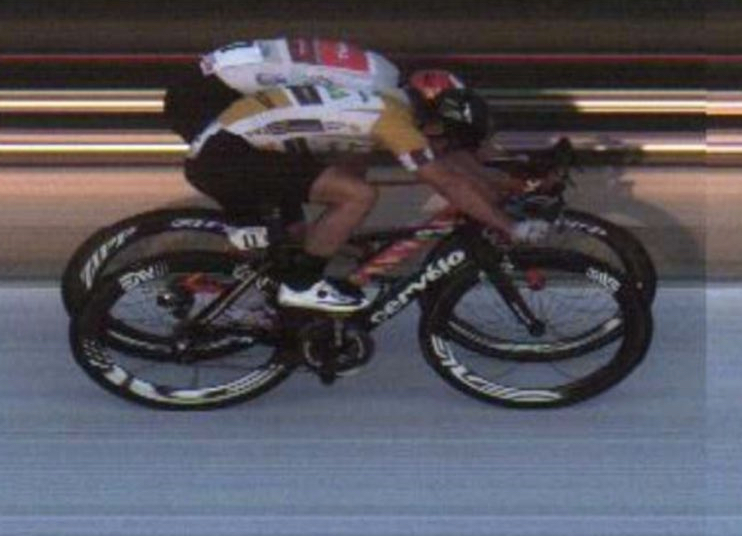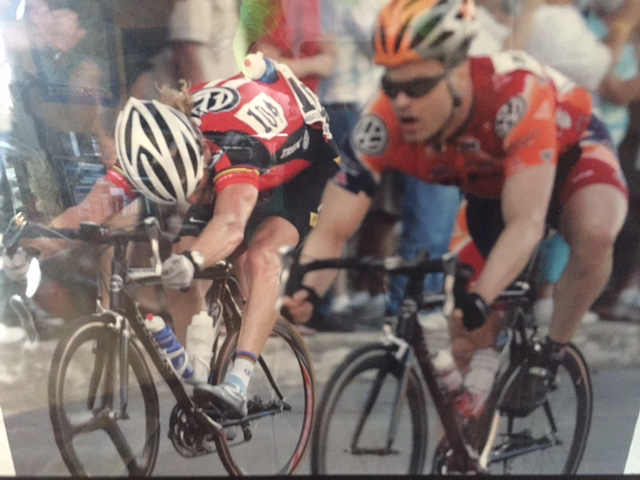I just was looking at the results from the Tour of Qatar this morning and saw that Alexander Kristoff beat Mark Cavendish in today’s stage by nearly nothing. That should be an interesting duel this season. Anyway, it got me thinking about how important a bike throw can be at the end of a race.
I’m really not sure where I learned how to throw my bike. It was just part of messin’ around training back when I was a kid, I think. It was one of the things we all did when we sprinted for stop ahead signs or city limits.
Wherever I learned it, if you don’t know how to throw your bike, then you need to learn. And I guess you do this by going out and training with other guys and doing sprints.
One thing this individualized training has done is made the handling abilities of the riders much worse. Cycling is such a complicated sport it isn’t like anyone can have all the abilities by the time they turn professional. No rider has encountered all the conditions they need, even in 5-10 years that they can’t learn something. I learn or relearn something in just about every race I do.
Anyway, I deviate. Since nearly all races are photo timed at the finish, your front wheel is where you finish. Being able to position that wheel a few inches further ahead at the end of the race can make the difference. So many races have been won, or lost, by a bike throw.
I suggest if you’re not comfortable throwing your bike at the finish of a race, you skip the intervals one day and go out and practice.

You can see that Cavendish (in yellow) is going much faster than Kristoff because of the relationship of their rear wheels.

Here is a photo of a photo at the finish of the Burlington Road Race a long time ago. John Puffer is on my left. I’m pretty far off the back of my seat. It is over a 40 mph sprint and I wasn’t really as close as it looks. He is much faster than me.






Will probably help making your arms a little longer, too. The guy with the longest arms takes the win, not the one with fastest legs. Btw, is this why compact bars got so popular?
For me the bike throw is the epitome of why I race. I’m not a heavy watter, per se, and my races come down to if I can do the last few hundred meters effectively. I wrote about it early on in my blogging life.
The biggest mistake I see is not getting your butt off the saddle. Taylor Phinney, in the only World Championship RR tie I know of (for 3rd), didn’t throw his bike as well as the other guy in third. If Taylor had gotten his butt more off his saddle he’d have that bronze medal for himself.
You know this, but for the sake of the readers, if you just extend your arms, you’re not really throwing your bike. The whole idea of the bike throw is to get the bike moving forward a touch more than it would have normally. The only way to do that is to move something heavier back, namely the rider.
In a super simplified way, if you have a 160 lbs rider and a 16 lbs bike, and you jerk the rider back 1 inch, the bike will jerk forward 10 inches. Conservation of momentum or something. Same thing as when you fling a rider forward, the rider doing the flinging goes a bit backward, a lot if the “flingee” is much bigger.
So the idea of a bike throw is to push the rider’s body back as far as possible so that the bike goes forward as much as possible. Since the rider’s mass is in their torso, they need to get their torso as far back on the bike as possible. In extremely aggressive bike throws I’ve almost sat on my rear wheel and my saddle’s back was poking into my stomach/chest.
Of course if you’re sprinting against me please don’t apply any of the above. Please don’t practice bike throws when you’re rolling around the parking lot before a ride, or on an easy ride, or even, after practicing like before, on group rides or even races. 🙂
Just ask Rebecca Twigg:
http://www.teamusa.org/~/media/TeamUSA/Cycling/Carpenter_Twigg_1984_800x375.jpg?la=en&%20width=100%;
What does the relationship of the rear wheels have to do with a riders’ speed?
Bike throws have won me a few races and got me on the podium on a few more. A reverse variation of the bike throw can help out on a team time trial every time you slide in at the back.
euro-Cavendish’s bike seems smaller. His front wheel is nearly even with Kristoff’s at the line, but his rear wheel crosses the line way before Kristoff’s, showing he is going much faster. If the rule was who’s complete bike crossed the finish line first, then Cavendish would have won the race.
I have a photo finish picture of myself in the Coor’s classic where I lose a sprint but my rear wheel is about at the rear dropout of the guy I was sprinting. That means I was travelling much faster than the other guy crossing the line.
I just watched the video. Cav didn’t really throw his bike, and in fact Kristoff really didn’t either, although he at least got his butt off the saddle. I think they were both absolutely maxed out.
Aki-I haven’t seen the video, but by looking at the photo, they are both throwing their bikes. They are both probably really good at it and are doing it right at the line.
Steve, don’t forget, one bike’s wheelbase (dropout to dropout) may be shorter than the other.
I’d watch the video. I’m surprised at how much of a “non-throw” it is at the line. No lunging. With the finish that close I thought for sure it’d be a last gamble, all-in bike throw for each of them. Instead it’s a bit weak. It looked like Cav was going to get it but then it went pear shaped for him in the last few meters. I think that with the headwind both guys were just dying. It’s a good finish, nonetheless.
Someone give that puppy a belly rub!
dave- Cav’s bike isn’t 3 inches shorter than Kristoff’s. It is speed that makes the photo’s perception of a shorter bike. Cav’s bike moved faster through the camera, thus is shorter. Think of if Cav was going twice as fast as Kristoff. Their front wheels would be in the same positions, but Cav’s bike would be half as long as Kristoff’s.
I think Tucker has started to look like Steve already!
Puffer left our team more than a few years ago, I wonder who he’s riding for now.
Steve, a photo is a photo. The first front wheel with the front edge of the tire breaking the invisible vertical plane of the finish line wins! Yea! That simple. Doesn’t matter how the rear wheel looks. The faster finishing bike is not going to appear shorter. And just like in football touchdowns, breakin the goalline plane. Although, in a lot of smaller races with no phototimers, a winning wheel can be the one touching the finish line at the pavement first!
dave-It’s not a normal photo. The photo is just a sliver of the finish line. The camera records only that which moves across the line. So when the bicycles move across the line they can seem different “lengths” because one bike is moving faster than the other.
Like the example above, say two guys come to the line nearly tied. If one rider is moving twice the speed as the other, the front wheels will be tied and one rider, the faster one, will seem half as long. He is moving through the space in half the time, thus shorter.
I can post photos where the bikes look really deformed, one stretched out and then other compact.
http://www.bikeforums.net/bicycle-mechanics/941203-spokes-appear-weirdly-curved-sprint-finish-photo.html
Steve, I understand all that. I’m saying that photography can be very deceptive. The photofinish picture simply shows who’s front wheel broke the vertical plane first. All the distortions in a finish photo don’t matter. No matter what the length of the bike is, although there are some advantages to the shorter bike but that’s another discussion. Again, some races without photofinish cameras get decided by the contact point of front wheel on the line and not the front edge.
Jpete — agreed!